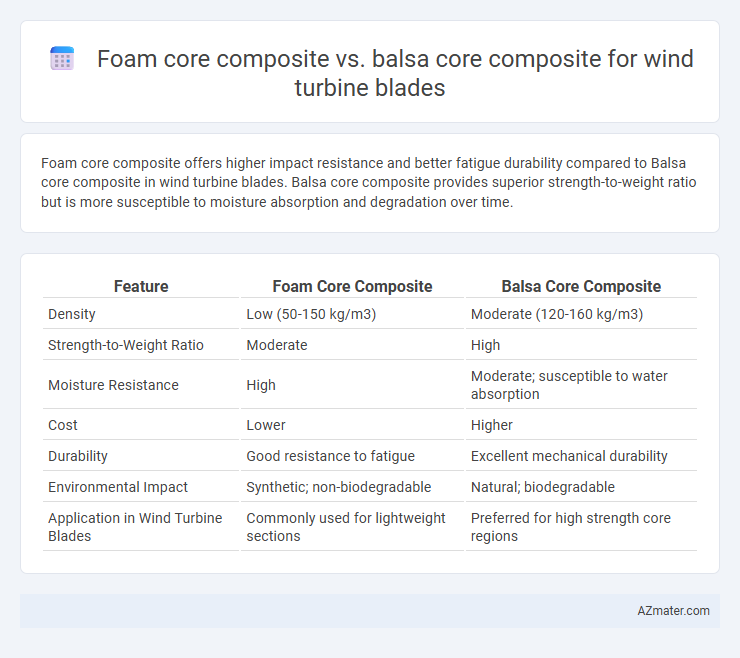Foam core composite offers higher impact resistance and better fatigue durability compared to Balsa core composite in wind turbine blades. Balsa core composite provides superior strength-to-weight ratio but is more susceptible to moisture absorption and degradation over time.
Table of Comparison
| Feature | Foam Core Composite | Balsa Core Composite |
|---|---|---|
| Density | Low (50-150 kg/m3) | Moderate (120-160 kg/m3) |
| Strength-to-Weight Ratio | Moderate | High |
| Moisture Resistance | High | Moderate; susceptible to water absorption |
| Cost | Lower | Higher |
| Durability | Good resistance to fatigue | Excellent mechanical durability |
| Environmental Impact | Synthetic; non-biodegradable | Natural; biodegradable |
| Application in Wind Turbine Blades | Commonly used for lightweight sections | Preferred for high strength core regions |
Introduction to Wind Turbine Blade Core Materials
Foam core composites and balsa core composites are critical materials in wind turbine blade construction, providing essential structural support and weight reduction. Foam cores, typically made from PVC or PET, offer excellent durability, lightweight properties, and resistance to moisture, making them suitable for large blade applications. Balsa core composites provide superior stiffness-to-weight ratio and natural damping, enhancing blade performance and longevity in dynamic wind conditions.
Overview of Foam Core Composite Technology
Foam core composite technology in wind turbine blades involves using lightweight, high-strength foam materials such as PVC, PET, or polyurethane as the core, bonded between fiber-reinforced composite skins to enhance stiffness and reduce weight. This technology provides improved impact resistance and fatigue performance compared to traditional balsa core composites, making it suitable for large-scale blade structures subjected to dynamic loading. Foam cores also offer better moisture resistance and manufacturing consistency, contributing to longer blade lifespan and reduced maintenance costs.
Key Features of Balsa Core Composite Structures
Balsa core composite structures in wind turbine blades offer exceptional strength-to-weight ratios, enhancing overall blade stiffness and fatigue resistance under cyclic loading conditions. The natural cellular structure of balsa provides superior impact absorption and delamination resistance compared to foam core composites, improving blade durability in harsh operational environments. High moisture resistance and thermal insulation properties of balsa cores contribute to maintaining structural integrity and performance efficiency over the turbine's lifespan.
Mechanical Properties: Strength and Stiffness Comparison
Foam core composites exhibit higher impact resistance and better fatigue performance while offering moderate stiffness for wind turbine blades, making them suitable for dynamic loading conditions. Balsa core composites provide superior stiffness-to-weight ratios and enhanced compressive strength, resulting in increased structural rigidity crucial for large blade spans. The choice between foam and balsa cores depends on balancing the need for toughness and stiffness to optimize blade lifespan and aerodynamic efficiency.
Weight and Density Considerations for Blade Design
Foam core composites typically offer a lighter alternative to balsa core composites in wind turbine blade design, with densities ranging from 80 to 200 kg/m3 compared to balsa's 160 to 320 kg/m3. Lower density foam cores reduce overall blade weight, improving aerodynamic efficiency and decreasing gravitational loads on turbine structures. Balsa cores provide higher stiffness-to-weight ratios but increase blade mass, potentially impacting turbine longevity and dynamic performance.
Durability and Fatigue Performance in Operational Environments
Foam core composites in wind turbine blades exhibit robust durability with enhanced resistance to moisture ingress and environmental degradation, promoting longer service life under varying operational conditions. Balsa core composites, while offering superior stiffness-to-weight ratios, tend to show increased susceptibility to fatigue damage due to natural material variability and moisture absorption, affecting long-term fatigue performance. Optimizing core selection for wind turbine blades involves balancing foam core's consistent durability against balsa's favorable mechanical properties for improved fatigue resistance in demanding wind environments.
Cost Analysis: Material, Manufacturing, and Lifecycle
Foam core composites generally offer lower material costs compared to balsa core composites due to their synthetic nature and ease of sourcing, reducing raw material expenses for wind turbine blades. Manufacturing foam core composites is often faster and less labor-intensive, resulting in reduced production costs and shorter lead times. While balsa core composites may have higher initial costs, their superior strength-to-weight ratio and durability can lower lifecycle expenses by improving blade performance and extending service intervals.
Sustainability and Environmental Impact Assessment
Foam core composites in wind turbine blades offer lower environmental impact due to reduced material density and energy consumption during manufacturing, enhancing sustainability through recyclability and lower greenhouse gas emissions. Balsa core composites provide exceptional mechanical strength with natural, biodegradable properties, promoting sustainability by utilizing renewable wood resources and enabling easier end-of-life disposal with minimal ecological footprint. Environmental impact assessment favors balsa cores for their carbon sequestration potential and reduced toxic waste, while foam cores excel in performance-to-weight ratio and long-term durability, requiring balanced evaluation for eco-friendly wind turbine design.
Real-world Performance: Case Studies and Field Data
Foam core composites in wind turbine blades demonstrate superior fatigue resistance and weight reduction, enhancing blade longevity in offshore conditions, as evidenced by Siemens Gamesa's 5 MW blade field tests. Balsa core composites offer higher stiffness-to-weight ratios, crucial for load-bearing sections, with Vestas reporting 15% improved load tolerance in land-based turbines using balsa cores. Comparative field data from GE Renewable Energy indicate foam cores reduce maintenance downtime by 12%, while balsa cores achieve better impact resistance, highlighting tailored performance benefits according to operational environments.
Conclusion: Choosing the Optimal Core Material for Wind Turbine Blades
Foam core composites offer lower density and improved fatigue resistance, making them suitable for lightweight wind turbine blades with high durability requirements. Balsa core composites provide exceptional stiffness-to-weight ratio and superior compressive strength, enhancing load-bearing capacity and overall blade performance in demanding environments. Selecting the optimal core material depends on balancing factors such as mechanical properties, cost-efficiency, environmental conditions, and blade size to maximize energy output and lifespan.

Infographic: Foam core composite vs Balsa core composite for Wind turbine blade
 azmater.com
azmater.com